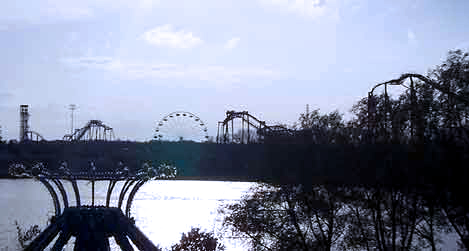
After Premier Parks purchased Geauga Lake in 1996, it invested several million dollars in new rides including a new water ride. Things looked promising for the future. That same year the company went public with a stock sale and raised $70 million. This new money would allow Premier Parks to improve it’s existing properties and pursue further expansion. Both of these actions would determine the eventual fate of Geauga Lake and SeaWorld of Ohio.
In the last post, I said that the most important factor in all of this wasn’t who, but when. If your a person born in this century, you probably don’t know much about 1998. I doubt they teach it much in history class. In terms of importance and impact on today, it would be worth spending about, oh, maybe a semester of high school on the year 1998. Why? The after-effects are seen in much of our lives today. This is because of what started happening with money.
This paragraph and the next one are the explanation of the above (so if you don’t care about corporate finance, you can skip them). In the 1990s, some strange things started to happen in the stock market. In late 1990, the Dow Jones industrial average index closed at a value of 4,500. Ten years later, at the end of 1999, it closed at just shy of 17,000. What that means is, if you invested $1000 in the index in 1990, you’d have a little over $3,700 ten years later. Wow, huge returns! You didn’t have do anything for it, other that make an investment. This was mirrored in the larger economy. Companies were starting up, pulling in capital (money), even if they had no profits. Everyone expected that companies would just grow and be profitable. This was especially true in technology (Google was founded in 1998 for example). With new and traditional companies increasing in share value every month, it looked like these guys and girls really knew what they were doing. When things are good, people tend to accept it. Only when things are bad, do people start looking for answers.
Looking back now, a demographic trend drove this. Baby boomers (my parents generation) had children (my generation) leaving home and going out on their own in large numbers in the 1990s. Baby boomers were also at the highest wages of their careers. Many of them hadn’t saved enough for retirement. Combined with new online access to the stock market, many poured money into it. This flooded the capital markets, which drove up prices for stocks. More dollars chasing the same amount of investments, products, houses, or whatever, drives up prices. It’s pretty simple. Companies flush with high stock prices/values pursued mega mergers. Exxon bought Mobil. BP bought Amoco. CitiCorp bought Travelers. This last transaction is especially interesting since through most of the 20th century, commercial banks like CitiCorp and investment banks like Travelers weren’t allowed to merge. It was against the law. Too risky. That law was changed in 1999, after the merger. More banks would merge, and soon banks would become to big to fail.
In 1998, Premier Parks went big. They purchased Six Flags from Time Warner for $1.9 billion dollars. You may never have taken a finance class, but there’s still an obvious question here. If they raised $70 million dollars in cash in 1996 and paid almost $2 billion dollars for something in 1998 just two years later, where did they get the money? Answer: They borrowed it, at least most of it.
Corporations can borrow in ways that consumers can’t, usually by issuing bonds. These are sold on a market, rather than borrowed from a bank, and corporations can issue as many as the market will bear. If planning to invest, bonds/debt tied to increased revenue and profits can be a smart way to finance (pay for) growth, without issuing more ownership stock. However, in the case of Premier Parks, they were buying Six Flags from Time Warner, a company that had other assets. Major media companies had built or bought theme parks for years, including Disney, Universal, and Paramount. For them it was a sideline. They all had other primary businesses.
Six Flags would now have an owner that was only a theme park operator. One that had taken massive debt, which would require large cash interest payments. Six Flags would need to increase attendance at the parks to generate enough funds to cover the cost of all this debt.
Like I’ve said above, there were many companies in many industries all doing the same thing at the same time in 1998. They were all betting on growth, lots of it, to cover their increasing costs.
It’s easy to put growth on a spreadsheet and bet it will happen. Making it happen is much harder, as many companies were about to find out.